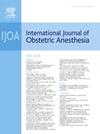雷马唑仑在产科患者中的应用:一项单中心回顾性研究(2021-2024)
IF 2.3
3区 医学
Q2 ANESTHESIOLOGY
引用次数: 0
摘要
雷马唑仑是一种超短效静脉注射苯二氮卓类药物,被批准用于手术镇静和全身麻醉。其良好的药代动力学特征,包括起效快、对环境敏感的半衰期短和最小的心血管抑制,使其成为产科麻醉的潜在药物,在产科麻醉中,产妇稳定和胎儿安全是至关重要的。方法本综述评估了雷马唑仑在产科使用的药理学概况、临床应用、安全性考虑和新出现的证据。使用PubMed和Ovid数据库(创建至2025年4月1日)进行了全面的文献检索,以获取与雷马唑仑在产科环境中使用相关的英语手稿。搜索词包括雷马唑仑在分娩镇痛,剖腹产,终止妊娠和程序镇静期间产科护理。对研究设计或手稿类型没有限制;然而,灰色文献和非同行评议的来源被排除在外。结果关于雷马唑仑在产科麻醉中的应用,现有文献主要包括病例报告(n=)、病例系列(n=)和随机对照试验(n=)。这些结果表明,雷马唑仑可以安全地用于高危产科人群,包括那些患有心脏病的产妇,提供有效的镇静,稳定的血流动力学,高患者满意度和良好的母胎结局。氟马西尼作为逆转剂的可用性增加了安全边际。虽然初步发现令人鼓舞,但目前的证据受到研究中评估的小队列的限制。需要更大规模的前瞻性研究来验证其有效性,确认孕产妇和新生儿的安全性,解决液体相容性问题,并支持产科使用指南的制定。本文章由计算机程序翻译,如有差异,请以英文原文为准。
Remimazolam use in obstetric patients: a single-center retrospective study (2021–2024)
Background
Remimazolam is an ultra-short-acting intravenous benzodiazepine approved for procedural sedation and general anaesthesia. Its favourable pharmacokinetic profile, including rapid onset, short context-sensitive half-time, and minimal cardiovascular depression, makes it a potential agent for obstetric anaesthesia, where maternal stability and fetal safety are paramount.
Methods
This scoping review evaluates the pharmacologic profile, clinical applications, safety considerations, and emerging evidence for the use of remimazolam in obstetric settings. A comprehensive literature search was conducted using PubMed and Ovid databases (inception to April 1, 2025), for English-language manuscripts related to remimazolam use in obstetric contexts. Search terms included remimazolam during labour analgesia, caesarean delivery, termination of pregnancy, and procedural sedation during obstetric care. No restrictions were placed on study design or manuscript type; however, grey literature and non-peer-reviewed sources were excluded.
Results
The existing literature on remimazolam in obstetric anaesthesia consists primarily of case reports (n=), case series (n=) and randomised control trials (n=). These suggest that remimazolam may be safely used in high-risk obstetric populations including those with maternal cardiac disease, providing effective sedation, stable haemodynamic, high patient satisfaction and favourable maternal-fetal outcomes. The availability of flumazenil as a reversal agent adds a safety margin.
Conclusion
While preliminary findings are encouraging, the current evidence is limited by the small cohorts evaluated in studies. Larger prospective studies are needed to validate its efficacy, confirm maternal and neonatal safety, address fluid compatibility concerns, and support guideline development for obstetric use.
求助全文
通过发布文献求助,成功后即可免费获取论文全文。
去求助
来源期刊
CiteScore
4.70
自引率
7.10%
发文量
285
审稿时长
58 days
期刊介绍:
The International Journal of Obstetric Anesthesia is the only journal publishing original articles devoted exclusively to obstetric anesthesia and bringing together all three of its principal components; anesthesia care for operative delivery and the perioperative period, pain relief in labour and care of the critically ill obstetric patient.
• Original research (both clinical and laboratory), short reports and case reports will be considered.
• The journal also publishes invited review articles and debates on topical and controversial subjects in the area of obstetric anesthesia.
• Articles on related topics such as perinatal physiology and pharmacology and all subjects of importance to obstetric anaesthetists/anesthesiologists are also welcome.
The journal is peer-reviewed by international experts. Scholarship is stressed to include the focus on discovery, application of knowledge across fields, and informing the medical community. Through the peer-review process, we hope to attest to the quality of scholarships and guide the Journal to extend and transform knowledge in this important and expanding area.

 求助内容:
求助内容: 应助结果提醒方式:
应助结果提醒方式:


